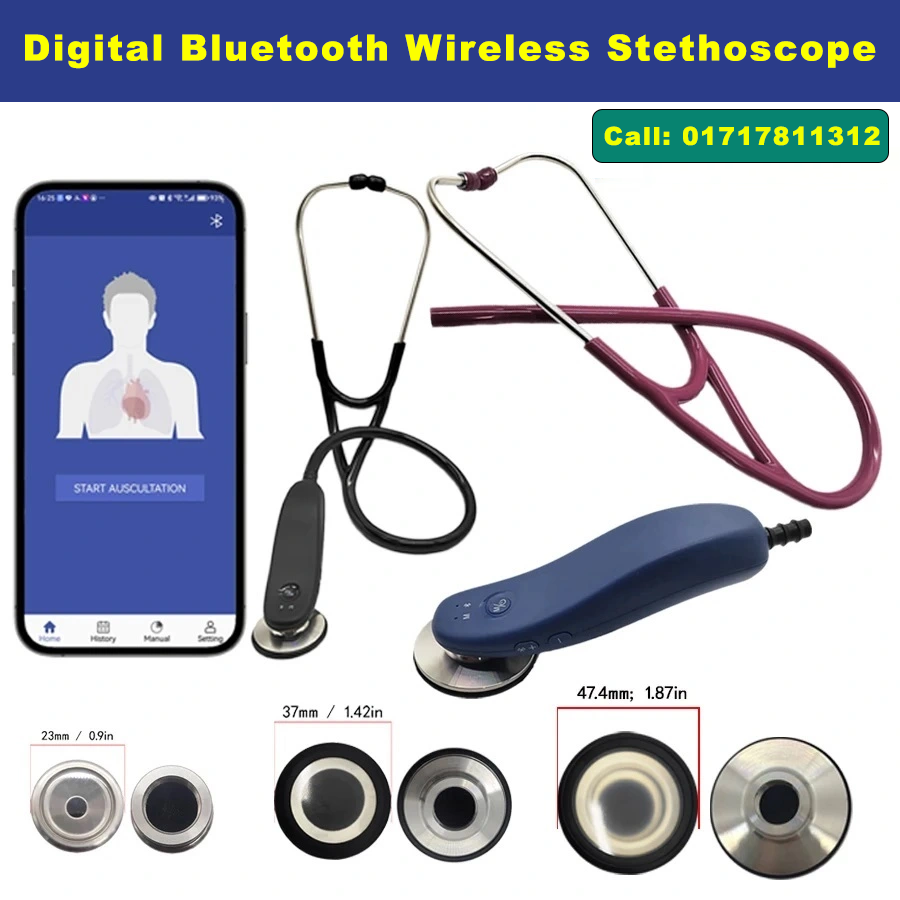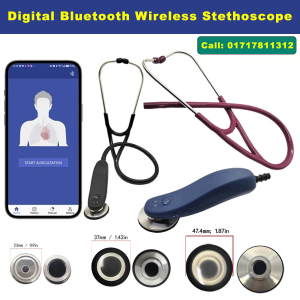The Ultimate Guide to Digital Bluetooth Wireless Stethoscopes
Revolutionizing Auscultation for the Modern Healthcare Era
1. Introduction
The stethoscope has long been the iconic symbol of the medical profession. From the days of René Laennec’s wooden monaural invention in 1816 to the dual-head Littmann of the 20th century, the humble stethoscope has seen only incremental changes — until now.
Welcome to the digital era, where Digital Bluetooth Wireless Stethoscopes are revolutionizing the way clinicians listen, diagnose, and treat. These devices are more than just futuristic accessories — they’re powerful diagnostic tools designed to meet the complex demands of modern medicine.
Whether you’re a physician, nurse, medical student, or remote healthcare provider, this guide will walk you through everything you need to know about digital Bluetooth stethoscopes — from how they work, to how to choose one, and what the future holds.
Buy Now
2. Evolution of the Stethoscope
2.1 The Invention
The original stethoscope was developed by French physician René Laennec in 1816, using a wooden tube to amplify chest sounds.
2.2 From Acoustic to Amplified
Over the decades, innovations led to binaural stethoscopes, dual diaphragms, and acoustic enhancements. In the late 20th century, companies like 3M Littmann introduced electronic amplification.
2.3 Enter the Digital Age
The 21st century introduced:
- Sound amplification up to 40x
- Noise reduction algorithms
- Bluetooth connectivity
- Mobile app integration
- Telemedicine compatibility
Today’s stethoscopes are smart, connected, and designed for real-time diagnostics and data sharing.
3. What is a Digital Bluetooth Wireless Stethoscope?
A Digital Bluetooth Wireless Stethoscope is an advanced diagnostic tool that:
- Converts acoustic body sounds (like heartbeats, breath sounds) into digital signals
- Allows amplification, visualization, and recording
- Uses Bluetooth to connect with smartphones, tablets, or computers
- Enables wireless auscultation and remote sharing
It’s not just a better stethoscope. It’s a complete digital auscultation system.
4. How Does It Work?
Digital stethoscopes combine hardware and software components:
4.1 Sensor (Chest Piece)
- Picks up vibrations from the body (e.g., heart or lung sounds)
- Transduces them into electronic signals
4.2 Digital Signal Processor (DSP)
- Filters, amplifies, and processes the signals
- Eliminates ambient noise using advanced algorithms
4.3 Bluetooth Module
- Sends the processed audio to paired devices (headphones, phones, computers)
4.4 Mobile App
- Displays sound waveforms in real time
- Records audio for playback or sharing
- Offers cloud backup, patient profiles, and AI insights (in some models)
5. Key Features and Technology
Let’s break down the cutting-edge tech behind these devices:
| Feature | Description |
|---|---|
| Amplification | Up to 40x normal auscultation |
| Noise Cancellation | Digital filters remove ambient interference |
| Bluetooth Connectivity | Seamless pairing with smart devices |
| Recording & Playback | Store, replay, or forward sounds to specialists |
| Cloud Storage | Patient data saved securely online |
| Visualization | Waveform display for more precise diagnostics |
| AI Integration | Some models analyze sound patterns to detect anomalies |
6. Benefits Over Traditional Stethoscopes
6.1 Clinical Accuracy
Amplification and filtering improve detection of faint murmurs and subtle pulmonary abnormalities.
6.2 Telemedicine
Remote auscultation becomes possible — essential during pandemics and for rural healthcare.
6.3 Documentation & Education
Recorded sounds enhance patient records and support medical training.
6.4 Accessibility
Hearing-impaired clinicians can use visual feedback or connect to hearing aids.
6.5 Integration
Easily link patient data with Electronic Medical Records (EMRs).
7. Use Cases and Applications
7.1 General Practice
Routine physicals with enhanced precision.
7.2 Cardiology
Clearer detection of systolic/diastolic murmurs, arrhythmias, and more.
7.3 Pulmonology
Auscultate wheezing, rales, crackles — even remotely.
7.4 Pediatrics
Capture and record fast-changing heart/lung sounds in children.
7.5 Medical Education
Replay and analyze audio for students during rounds or lectures.
7.6 Home & Telehealth Monitoring
Used by visiting nurses or even patients at home under doctor guidance.
8. Top Digital Stethoscope Brands
Several manufacturers are at the forefront of digital stethoscope innovation. Here are some of the most reputable:
HMYL Digital Stethoscope
- Wireless, smartphone-friendly, and designed for modern clinicians.
- Features: Bluetooth audio transmission, sound recording, lightweight build.
9. Buyer’s Guide: Choosing the Right Device
When selecting the right digital stethoscope, consider:
✔️ Your Medical Specialty
- Cardiology: Go for devices with ECG and highest sound fidelity.
- Primary Care: A mid-range model with recording and Bluetooth is usually enough.
- Telehealth: Must include app support and wireless sharing.
✔️ Audio Quality
- Look for amplification power, frequency range, and noise reduction.
✔️ Battery Life
- Some last up to 60 hours on a single charge. Others require frequent recharging.
✔️ Compatibility
- Works with iOS, Android, and optionally with EMR software.
✔️ Storage & Sharing
- Consider models that allow audio recording, cloud storage, and waveform sharing.
✔️ Price Range
- Entry-level: $100–$200
- Mid-range: $250–$350
- High-end: $400–$600+
10. Clinical Validation and Certifications
Any medical diagnostic device should meet regulatory requirements. Check for:
✅ CE Mark
- Ensures compliance with European health, safety, and environmental protection standards.
✅ ISO Certification
- Verifies quality control processes in manufacturing.
Without proper certifications, avoid using the device in professional settings.
11. Integration with Mobile Devices
📱 Smartphone Integration
- Connects via Bluetooth to a dedicated app.
- Shows records sounds, and even offers patient tagging.
12. Data Privacy and Security
Because these devices collect and transmit patient data:
- Use devices with end-to-end encryption.
- Confirm whether local or cloud storage is used.
- Always keep apps and firmware updated.
13. Troubleshooting and Maintenance Tips
To get the best performance and longevity out of your digital stethoscope, follow these best practices:
🔧 Troubleshooting Common Issues
- Bluetooth Not Connecting
→ Ensure device is charged and Bluetooth is enabled on your phone. Reboot both devices. - Poor Sound Quality
→ Check for firmware updates, adjust volume on the app, and make sure the diaphragm is clean. - App Crashing or Freezing
→ Close background apps, clear cache, and check for software updates. - Recording Not Saving
→ Verify storage permissions for the app and check available memory.
🧼 Cleaning and Care
- Use alcohol wipes to clean the diaphragm and tubing (if present).
- Avoid submerging in liquid.
- Do not use abrasive cleaners.
- Store in a cool, dry place in its case.
14. Common Myths and Misconceptions
Let’s bust some myths:
❌ “Digital stethoscopes are just expensive toys.”
✅ Truth: They are powerful diagnostic tools with amplified audio, recording, and sharing capabilities that improve patient care.
❌ “They’re too complicated to use.”
✅ Truth: Most models are intuitive, with one-button operation and user-friendly apps.
❌ “Bluetooth means low sound quality.”
✅ Truth: Modern Bluetooth technology ensures high-fidelity audio, often better than acoustic auscultation.
❌ “They can’t be used for real diagnoses.”
✅ Truth: Many devices are FDA-approved and used in hospitals, clinics, and universities worldwide.
15. Price Range and Budget Considerations
Here’s a general guide to pricing:
| Budget | Features | Examples |
|---|---|---|
| Under $150 | Basic Bluetooth stethoscopes, no recording | Entry-level |
| $150–$300 | Noise reduction, sound recording, app support | HMYL Premium |
| $300–$600 | Advanced audio, AI integration, ECG | Eko DUO, Littmann CORE |
| $600+ | Specialty devices, multi-sensor tech, hospital-grade | Thinklabs One Pro, custom telemedicine kits |
16. Global Market Trends
The demand for digital stethoscopes is rising rapidly. Here’s why:
🌍 Telemedicine Growth
Driven by the pandemic and rural healthcare expansion, remote auscultation is becoming a norm.
📈 Market Forecast
The global digital stethoscope market is projected to exceed USD 1.5 billion by 2030, with CAGR of 6–9%.
💼 Healthcare Digitization
With EMRs and AI becoming essential, smart stethoscopes are a critical part of the diagnostic ecosystem.
🔬 AI Diagnostics
AI-assisted auscultation is evolving. Devices now suggest murmurs, wheezing, or arrhythmia detection.
17. Future of Digital Auscultation
Here’s what’s on the horizon:
🤖 AI Integration
AI will not just detect anomalies — it’ll predict cardiac events, recommend treatment, and even generate reports.
☁️ Cloud-First Ecosystems
Doctors will collaborate across continents by listening to the same chest sound in real time.
📲 All-in-One Diagnostic Kits
Integrated with ECG, BP, SpO2, and even ultrasound into pocket-sized telehealth kits.
🧠 Augmented Auscultation
Combine auscultation data with imaging and lab results for deeper diagnostic insights.
18. Frequently Asked Questions (FAQs)
Q: Can I use a digital stethoscope for pediatrics?
A: Yes, many models come with pediatric and neonatal modes for high-frequency lung and heart sounds.
Q: Is Bluetooth safe for medical use?
A: Absolutely. Medical-grade Bluetooth operates within secure, encrypted standards.
Q: Can I share recordings with other doctors?
A: Yes. Most apps allow secure sharing via email, cloud, or even live streaming.
Q: How long does the battery last?
A: Most digital stethoscopes last 8–60 hours per charge, depending on the model and usage.
Q: Are digital stethoscopes approved by medical boards?
A: Many are FDA-cleared and CE-certified. Always verify before purchasing.
19. Final Thoughts
Digital Bluetooth wireless stethoscopes are not just a novelty — they’re essential tools in a rapidly evolving medical landscape.
Whether you’re diagnosing heart murmurs, listening to lung crackles, teaching students, or consulting via telehealth, a smart stethoscope enhances your diagnostic capabilities.
🛒 Looking to buy one?
Check out local suppliers like Unique Medi Trade in Bangladesh or authorized dealers near you. Always prioritize certified models with after-sales support.
Remember: Medicine is changing. Your tools should too.
📲 Ready to go digital? Embrace the stethoscope of the future — because your patients deserve the best.
Conclusion
Digital Bluetooth Wireless Stethoscopes are more than just modern gadgets—they’re vital tools in reshaping how healthcare is delivered globally. With their powerful capabilities and expanding accessibility, they bridge gaps in diagnostics, training, and care coordination. Whether you’re a practicing clinician, a medical educator, or a tech-savvy student, these devices are your gateway to smarter, faster, and more connected healthcare.


